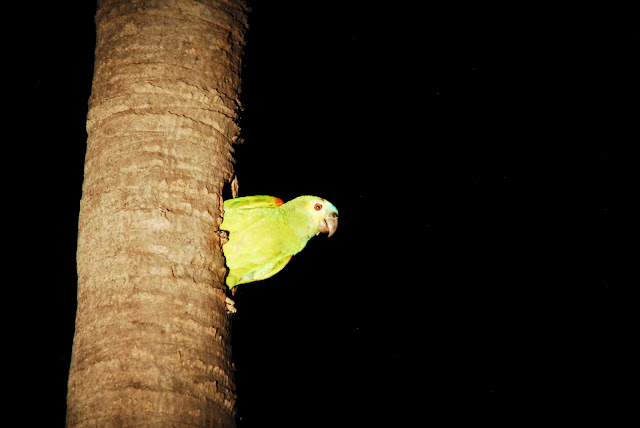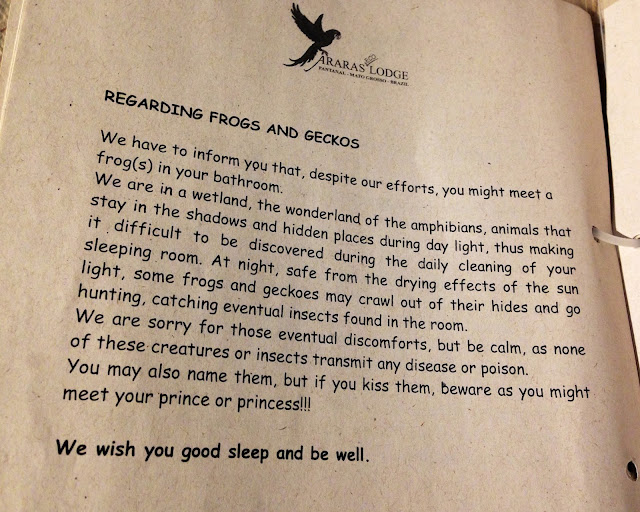September 2015
ATLANTIC RAINFOREST
RESERVA ECOLOGICA DE GUAPI ASSU
SOUTHERN PANTANAL
REFUGIO DA ILHA
NORTHERN PANTANAL
ARARAS ECOLODGE
The Pantanal is the largest wetland in the world. It is located in the states of Matto Grosso, and Matto Grosso del Sul, Brazil.
 |
| Reserva Ecologica De Guapi Assu (REGUA), a humid rainforest southeast of Rio. British national Nicholas Locke inherited this farmland from his family and is now trying to restore it to its original state. He works with government officials, international conservation groups and runs a research station on the premises. |
 |
| Nick Locke, right. News story about his project here. |
 |
| Waterfall at REGUA |
 |
| Guide Clive Saunders. On sabbatical from a teaching job in the U.K. Clive is traveling the world seeing wildlife. If you want to know how to get around Sri Lanka by bus, he's your man. |
 |
| Guide Wes Homoya searches for an elusive bird. That's a laser pointer he uses to show us where to look. |
 |
| Saw this fellow while picnicing at the waterfall in REGUA |
 |
| Marmosets |
 |
| Caimans are less aggressive than crocs or alligators. Joe spotted this one while boating in the Southern Pantanal. |
 |
| The Karps' adventures nearly always include encountering wildlife in the wild... and in bathrooms. Here is our first surprise guest, at the Reserva Ecologica de Guapi Assu. There was also a resident leech in the shower. Both pretty much kept to themselves. |
 |
| Cacique. These birds have bright red backs. Build unique nests - see pictures below. |
 |
| Cattle is big business on the Pantanal. |
 |
| Black collared hawk |
 |
| Kingfisher |
 |
| Water hyacinths |
 |
| Hiking in REGUA |
 |
| Yellow billed cardinal. It's really not a cardinal, they just call it that. |
 |
| Rufous hornero seen at Araras Ecolodge in the Northern Pantanal. |
 |
| Cattle in the Pantanal have been bred from a species originally from India. They can withstand the extreme heat. Ranchers regularly feed them crushed salt. |
 |
| The hyacinth macaw is the iconic species associated with the Pantanal. He's gorgeous, and highly intelligent. |
 |
| Horseback riding in the Southern Pantanal at Refugio da Ilha - at 5:30 am but so worth it. This is Ney, who was one of our guides but spoke only Portuguese. His pointer finger did all the work. |
 |
| Someone tell this man that texting while driving is verboten. |
 |
| Orin Gelderloos and Guide Stefan Grol. Stefan was born in Rio, raised in Guildford, Britain and moved to Brazil to help his father run his cattle ranch. He is now a guide, and painter. You can see his paintings of the Pantanal at www.stefangrol.com |
 |
| L-R: Orin Gelderloos, Guide Stefan Grol, Robert Hotaling, Debbie. |
 |
| Brocket deer. Most mammals emerge only at night so it was difficult to photograph them. We saw but could not photograph tapir, anteater, crab-eating foxes. |
 |
| Capybara. The world's largest rodent. Certainly the cutest. |
 |
| Could you make it up? Male curassow. |
 |
| With his girlfriend. |
 |
| Plush crested jay |
 |
| Seen on a night jeep ride in the Southern Pantanal. |
 |
Blowout heading from Cuiaba to the Northern Pantanal and Araras Ecolodge. Tadeu, our guide, and driver Jefferson fixed it in no time. The THI must have been over 100, even higher closer to the asphalt. One of the rare times an unpaved road would have been better.
|
 |
| Rhea |
 |
| These horses belong to Andre von Thuronyi, the owner of the Araras Ecolodge. He brings in tourists to fund his conservation efforts. These are Pantanal horses, which do well in the extreme heat and humidity. |
 |
| Capuchin monkey taps nuts to see if they're ripe. |
 |
| Opposable thumbs - plus a prehensile tail. Such talent. |
 |
| Wood storks roosting. |
 |
French film crew records huge female anaconda. There is a male anaconda right behind her. Their numbers have been decimated so we were fortunate to see one - even more fortunate to see two.
|
 |
| Andre explains the details of Anaconda courtship |
 |
Blue, a 4 year old captive-raised hyacinth macaw was given to Andre of Araras Ecolodge by Brazilian authorities. He is rehabilitating him for eventual release. Blue is learning to crack nuts. He is still frightened of other macaws.
|
 |
| This is what he SHOULD be eating. |
 |
| Caracara |
 |
Robert Hotaling and Joe canoeing on the El Claro River. The grownups kept a close eye on them and made sure their life vests were well secured.
|
 |
| Jabiru stork |
 |
| A full lunar eclipse occurred while we were in the Pantanal but it was too hazy to see it. Or so we were told. We were asleep. The next such eclipse will occur in 2033. We'll catch it then (?). |
 |
| Interesting decor at Refugio da Ilha |
 |
| Nesting box provided for wild hyacinth macaws. The boxes are part of the plan to restore the population. |
 |
| How long it takes for various items to decompose in this environment. Even the high temperatures and humidity can do only so much on plastic. It's an ecological nightmare. |
 |
| Blue fronted parrot. Parrots and parakeets abound on the Pantanal. |
 |
| Robert Hotaling was thrilled when this damsel fly decided to take a siesta on his finger. "Damsel flies are my favorite insect!" Robert is definitely my kind of traveling companion. |
 |
| We drove by this tree on two separate evenings and found this nocturnal parrot in the same position each time. |
 |
| Shidu, resident of Refugio Da Ilha. He gets extremely dirty and cools off in the river several times a day. He's a tad grimy. Pet at your own peril. |
 |
| Piranha soup. It was... fishy. |
 |
| Aaaaawwww... Baby capybara follows its mom. |
 |
Chachalaca birds. Named after the screaming sound they make all day, but especially at sunrise. Your alarm clock has nothing on these guys. Listen to them on the video below:
|
 |
The importance of checking out local ice cream offerings cannot be overstated.
|
 |
| Jabiru stork and offspring. So ugly, they're cute. |
 |
Cashews.
|
 |
Huh? Weird bug.
|
 |
Transportation at Araras. No four wheel drive. When it began raining, we got stuck, giving Tadeu the chance to tell us about the "mango rains"...
...and the opportunity to fix yet another ailing vehicle. Here he is at right, with the driver, putting chains on the tires so we can get out of the muck.
|
 |
| Although we stayed in the truck, it had no sides, so we got nearly as drenched as the drivers. We were shivering and laughing the entire time. |
 |
| Collared peccary |
 |
| Son of one of the workers at the rehabilitation/release center in the Northern Pantanal. The center takes in birds that have been caught in the black market and prepares them for eventual release. |
 |
| Toucan. We learned that there are many subspecies of toucan, but let's not get too picky. |
 |
| After this photo was taken, Donne Yvonne thoughtfully removed the head of our entree. |
 |
| Caipirinha: The national cocktail of Brazil and served pre-dinner. Consists of rum, sugar cane juice and lime. Very refreshing, especially when the temperature humidity index is 104. |
 |
| Racquel Locke preparing caipirinhas for our tour group. She and everyone else we met said that the weather was unseasonably hot, even for this area. Seated are Char and Orin Gelderloos and Jody. |
 |
| Squashes of all types are a big part of Brazilian cuisine. |
 |
| Vermilion flycatcher |
 |
Two local kids watch TV at a shop outside the Araras Ecolodge
|
 |
A path to one of the wildlife towers at Araras Ecolodge.
|
 |
| Because we need reminding. At a rest stop bathroom, enroute to the Cuiaba airport for our first flight enroute home. |
 |
Women receive the same instructions. It appears that many visitors to these rest rooms have been raised by wolves. Or maybe capybaras.
|































































































































































These pix are spectacular, and the running commentary is delightful. It makes me realize that I've come a long way from "let's go downstairs to the Edelbergs and see their vacation slides of the Catskills."
ReplyDelete